To master drone storytelling, you'll need to follow seven key steps. Start by choosing the right drone for your skill level and budget. Next, practice basic flight controls until they become second nature. Plan your aerial shots carefully, considering composition techniques like leading lines and symmetry. Craft your story through varied drone movements and shot types. In post-processing, refine your images and maintain visual consistency. Always adhere to legal and ethical guidelines when flying. Finally, learn to remove distractions and enhance image sharpness for professional results. These steps will set you on the path to creating compelling aerial narratives.
Key Takeaways
- Choose a suitable drone with good camera quality and user-friendly controls for beginners.
- Master flight controls and practice basic maneuvers to ensure safe and stable aerial footage.
- Plan your shots by scouting locations, considering lighting, and creating a storyboard for your narrative.
- Learn composition techniques like leading lines and symmetry to create visually appealing aerial photography.
- Integrate drone footage with ground shots and use various movements to enhance storytelling impact.
Choose Your Drone Wisely

When it comes to drone storytelling, selecting the right equipment is vital. You'll need to take into account several factors before making your choice.
First, evaluate your skill level. If you're a beginner, opt for a user-friendly model with features like automatic takeoff and landing, obstacle avoidance, and return-to-home functionality.
Next, think about the camera quality. Look for a drone with at least 4K video resolution and 12MP photo capability to guarantee sharp, high-quality footage. Gimbal stabilization is significant for smooth shots, so prioritize drones with this feature.
Battery life is another important aspect. Aim for a drone that offers at least 20-30 minutes of flight time per battery. This will give you ample opportunity to capture your shots without frequent interruptions.
Size and portability matter too, especially if you plan to travel with your drone. Foldable models are ideal for easy transport and quick setup.
Lastly, don't forget about your budget. While high-end drones offer superior features, there are plenty of capable mid-range options that won't break the bank.
Balance your needs with your financial constraints to find the perfect drone for your storytelling adventures.
Master Basic Flight Controls
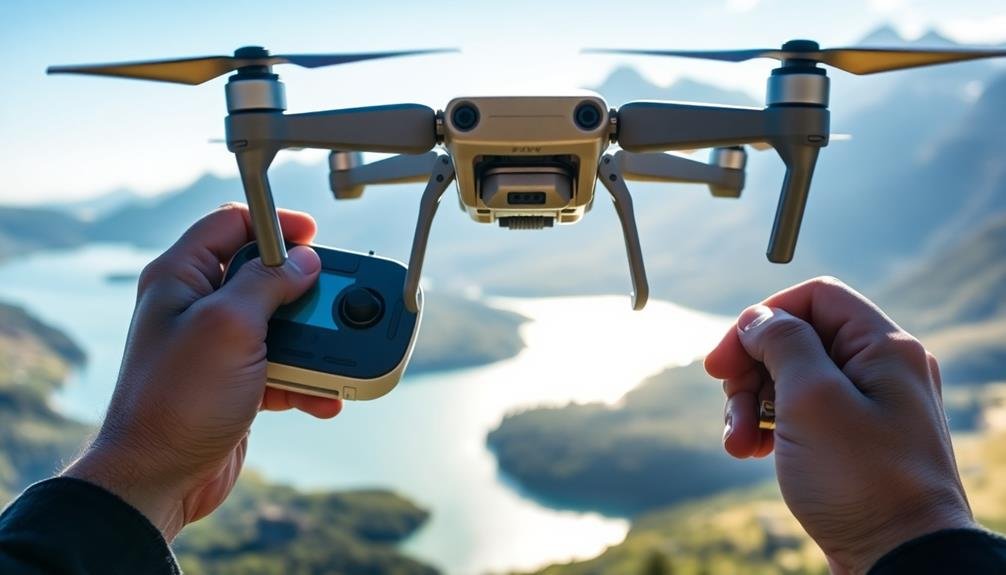
With your drone selected, it's time to focus on mastering the basic flight controls. Familiarize yourself with the remote controller and its various buttons, sticks, and switches. Start with simple maneuvers in an open area, away from obstacles and people. Practice hovering, ascending, descending, and moving in different directions.
Understanding the four primary flight controls is essential:
- Throttle: Controls altitude (up and down)
- Yaw: Rotates the drone left or right
- Pitch: Moves the drone forward or backward
- Roll: Moves the drone sideways (left or right)
Begin with slow, deliberate movements to get a feel for the drone's responsiveness. Gradually increase your speed and complexity as you gain confidence.
Pay attention to the drone's orientation, as it can be disorienting when it's facing you. Always maintain visual line of sight with your drone and be aware of your surroundings.
Practice flying in different weather conditions, but avoid strong winds or precipitation initially. Mastering these basic controls will provide a solid foundation for more advanced maneuvers and cinematography techniques.
Plan Your Aerial Shots

Once you've mastered basic flight controls, it's crucial to plan your aerial shots carefully. Start by scouting locations and identifying potential subjects or scenes that will tell your story effectively from the air.
Consider the time of day, lighting conditions, and weather forecast to capture the best possible footage. Sketch out a storyboard or shot list to visualize your narrative sequence. Include a mix of wide establishing shots, dynamic moving shots, and close-ups to create visual interest.
Think about unique angles and perspectives that only a drone can provide, such as revealing shots that start low and climb to showcase a landscape. Pay attention to composition rules like the rule of thirds and leading lines to create visually appealing frames.
Plan your flight paths to achieve smooth, cinematic movements. Consider incorporating natural elements like trees or buildings as foreground objects to add depth to your shots.
Don't forget to account for any necessary permits or restrictions in your chosen locations. Always prioritize safety and legal compliance when planning your aerial storytelling adventure.
Composition Techniques for Aerial Photography
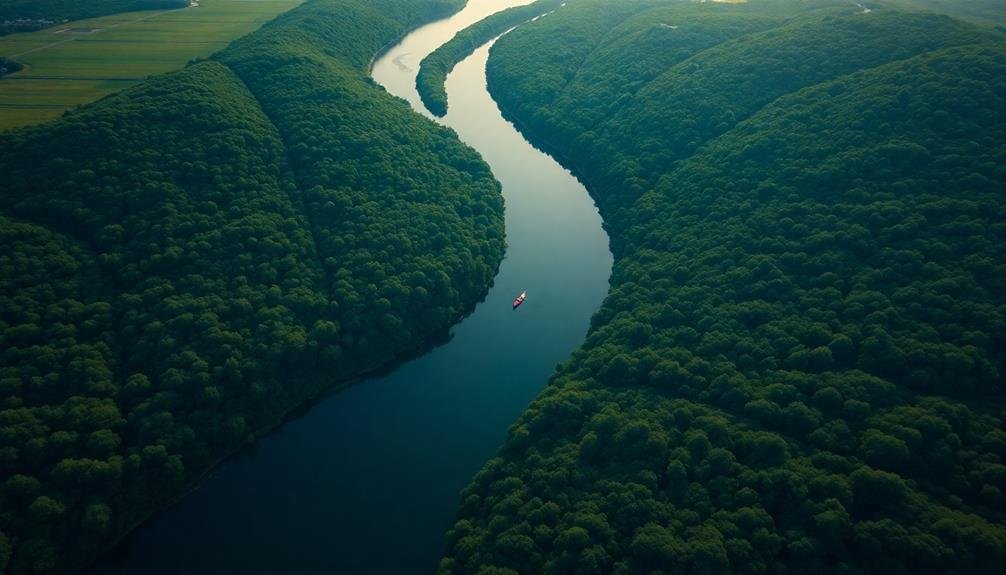
Aerial photography opens up a whole new world of compositional possibilities. As you soar above the landscape, you'll need to adapt your techniques to capture stunning images from this unique perspective. Remember that the rules of composition still apply, but with a twist.
When framing your shots, consider these aerial-specific composition techniques:
- Leading lines: Look for roads, rivers, or shorelines that guide the viewer's eye through the image.
- Symmetry and patterns: Seek out geometric shapes and repetitive elements in urban or natural landscapes.
- Negative space: Utilize empty areas to create contrast and draw attention to your subject.
- Scale and perspective: Include recognizable objects to provide context and emphasize the grandeur of the scene.
Don't forget to experiment with different altitudes and angles. Low flights can create dramatic perspectives, while higher altitudes reveal larger patterns and structures.
As you're composing your shots, keep an eye on your drone's battery life and maintain a safe distance from obstacles. With practice, you'll develop an eye for spotting compelling aerial compositions and create visually striking images that tell a unique story from above.
Storytelling Through Drone Footage
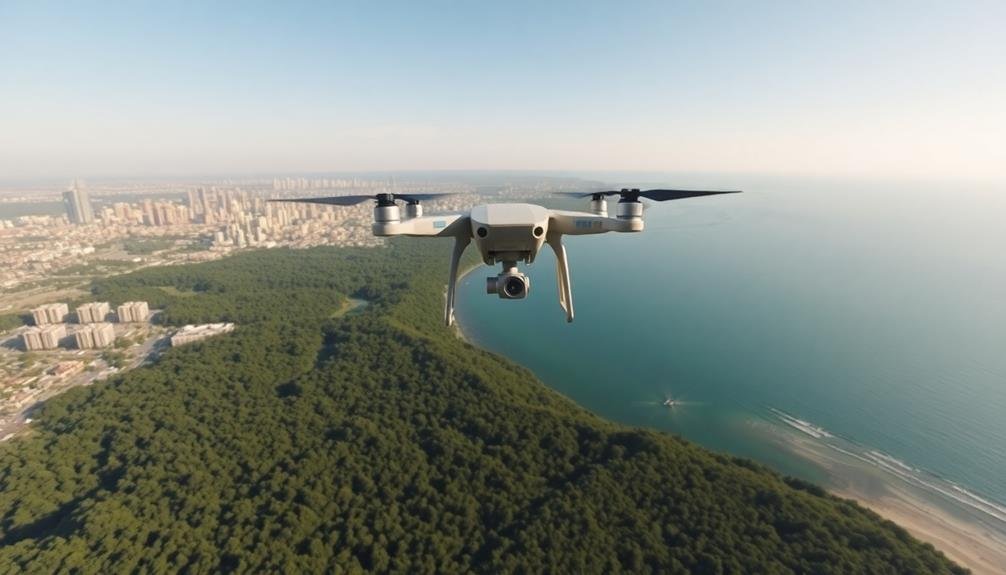
Drone footage offers a unique perspective that can elevate your storytelling to new heights. To craft compelling narratives, you'll need to plan your shots carefully and consider how they'll fit into your overall story arc. Think about the emotions you want to evoke and the message you're trying to convey.
Start by storyboarding your drone shots, considering how they'll complement ground-level footage. Use a variety of movements to keep your audience engaged:
| Movement | Effect | Example |
|---|---|---|
| Reveal | Builds anticipation | Fly over a hill to disclose a landscape |
| Follow | Creates connection | Track a subject moving through a scene |
| Orbit | Showcases context | Circle around a building or landmark |
| Establishing | Sets the scene | Wide shot of a location from high altitude |
| Shift | Connects scenes | Fly from one location to another |
Remember to vary your shot types and durations. Combine wide, sweeping landscapes with tighter, more intimate shots to create visual interest. Don't rely solely on drone footage; integrate it seamlessly with ground-level shots to provide a well-rounded perspective. By thoughtfully incorporating drone footage into your storytelling, you'll create a more immersive and engaging experience for your audience.
Post-Processing for Drone Images
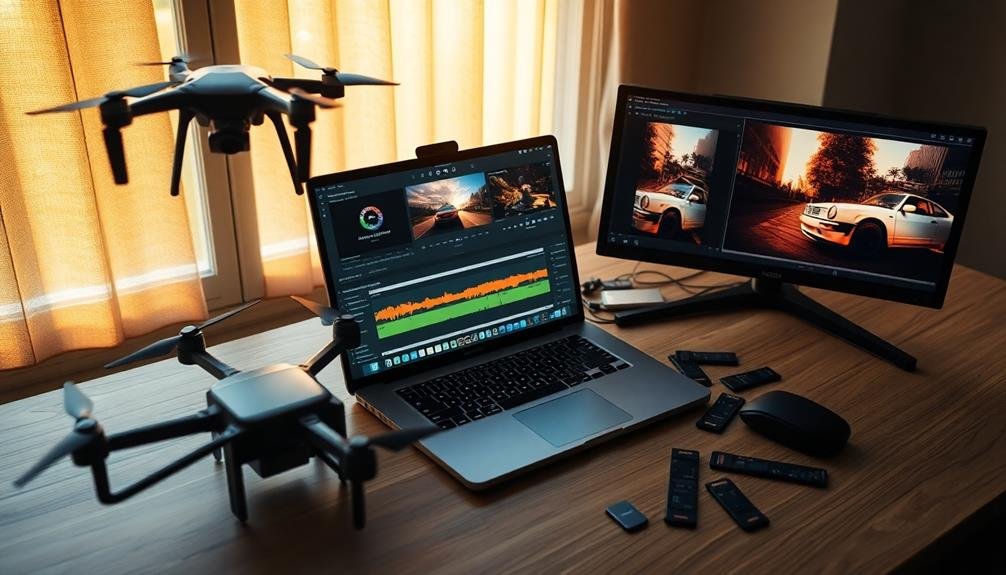
After capturing your drone footage, you'll need to refine your images through post-processing.
Focus on color correction and grading to enhance the visual appeal, remove distracting elements that may detract from your story, and sharpen your images for crisp, clear results.
These techniques will elevate your drone imagery, helping you create more impactful and professional-looking content.
Color Correction and Grading
In spite of capturing stunning aerial footage, your drone videos may still need some post-processing magic to truly shine. Color correction and grading are essential steps in enhancing your aerial storytelling. These techniques help you achieve a consistent look, set the mood, and draw viewers into your narrative.
Start by adjusting the basic color parameters:
- White balance: Verify your footage has the correct color temperature
- Exposure: Fine-tune the brightness of your shots
- Contrast: Adjust the difference between light and dark areas
- Saturation: Control the intensity of colors
Once you've corrected the basics, move on to color grading. This artistic process involves creating a specific visual style for your footage. You might opt for a warm, golden look for sunset shots or a cool, blue tone for winter scenes.
Use tools like curves, color wheels, and LUTs (Look-Up Tables) to achieve your desired aesthetic.
Remember to maintain consistency across your entire video. Subtle adjustments often work best for drone footage, as overly stylized looks can distract from the breathtaking aerial perspectives.
With practice, you'll develop your own unique style that enhances your drone storytelling and captivates your audience.
Removing Visual Distractions
Aerial masterpieces often come with unwanted elements that can detract from your storytelling. To create a fascinating narrative, you'll need to remove these visual distractions during post-processing.
Start by identifying objects that don't contribute to your story, such as power lines, vehicles, or construction equipment. Use your editing software's clone stamp or healing brush tools to carefully remove these elements. Work in small sections, matching textures and colors to seamlessly blend the edited areas.
For larger distractions, consider using content-aware fill tools, which intelligently replace removed objects with surrounding patterns. Pay attention to shadows and reflections, as they can reveal the presence of removed objects. Adjust these areas accordingly to maintain realism.
In some cases, cropping your image might be the simplest solution to eliminate distractions near the edges.
Enhancing Image Sharpness
Enhancing image sharpness is a crucial step in post-processing drone footage. It can make or break the visual impact of your aerial shots, turning good images into stunning ones.
To achieve maximum sharpness, you'll need to master a few key techniques in your editing software. Start by adjusting the overall sharpness of your image. Be careful not to overdo it, as excessive sharpening can introduce unwanted artifacts and noise.
Next, focus on local sharpening, which allows you to enhance specific areas of the image without affecting others. This is particularly useful for drone footage, where different parts of the frame may require varying levels of sharpness.
To further refine your image sharpness, consider these advanced techniques:
- Use high-pass sharpening for a more subtle effect
- Apply unsharp mask to enhance edge contrast
- Utilize frequency separation to sharpen details without affecting texture
- Experiment with deconvolution sharpening for a more natural look
Legal and Ethical Considerations
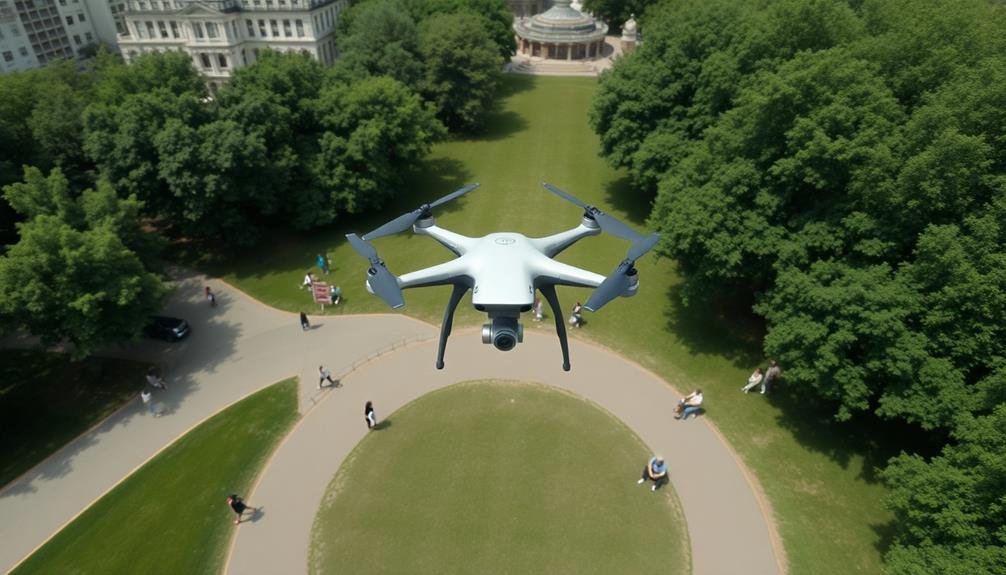
Responsible drone operators must navigate a complex landscape of legal and ethical considerations.
First, guarantee you're compliant with local and national regulations. In the US, register your drone with the FAA and obtain the necessary certifications. Familiarize yourself with airspace restrictions, no-fly zones, and altitude limits.
Always prioritize safety. Maintain visual line of sight with your drone and avoid flying over people or moving vehicles. Respect privacy rights by not filming in areas where individuals have a reasonable expectation of privacy, such as private residences or enclosed spaces.
Be mindful of environmental impacts. Avoid disturbing wildlife, particularly during sensitive periods like nesting seasons. Don't fly in protected natural areas without proper permits.
Consider the ethical implications of your storytelling. Guarantee your footage doesn't misrepresent situations or exploit vulnerable individuals. Be transparent about your use of drone footage and obtain necessary permissions when filming on private property or at events.
Lastly, stay informed about evolving regulations and best practices. Join professional organizations, attend workshops, and engage with the drone community to keep your knowledge current and maintain ethical standards in your work.
Frequently Asked Questions
How Do I Protect My Drone From Crashing During Flights?
To protect your drone from crashing, always fly within line of sight, avoid obstacles, and maintain proper altitude. Use GPS and return-to-home features, practice in open areas, and keep your drone updated. Don't fly in harsh weather conditions.
What's the Best Way to Transport a Drone Safely?
To transport your drone safely, you'll want to invest in a sturdy, padded case. Secure all components, including batteries, separately. Remove propellers, and use foam inserts to prevent movement. Don't forget to pack accessories and spare parts.
How Can I Extend My Drone's Battery Life During Filming?
To extend your drone's battery life while filming, you'll want to fly efficiently, avoid strong winds, use lower camera settings, keep batteries warm, and carry spares. Don't forget to fully charge before each flight and monitor power levels.
Are There Specific Weather Conditions I Should Avoid When Flying Drones?
You should avoid flying your drone in strong winds, rain, snow, or fog. Don't fly in extreme temperatures, near electrical storms, or in low visibility conditions. Always check local weather forecasts and regulations before taking off.
How Do I Clean and Maintain My Drone for Optimal Performance?
You'll need to regularly clean your drone's body, propellers, and camera lens. Keep batteries charged and stored properly. Check for loose parts, update firmware, and calibrate sensors. Don't forget to inspect your drone before each flight.
In Summary
You're now equipped with the essentials of drone storytelling. Remember, it's not just about flying; it's about creating compelling narratives from above. As you practice, you'll develop your unique style. Don't forget to stay updated on regulations and always respect privacy. With these steps, you're ready to elevate your storytelling—literally. So charge those batteries, plan your shots, and take to the skies. Your aerial adventures await!

As educators and advocates for responsible drone use, we’re committed to sharing our knowledge and expertise with aspiring aerial photographers.
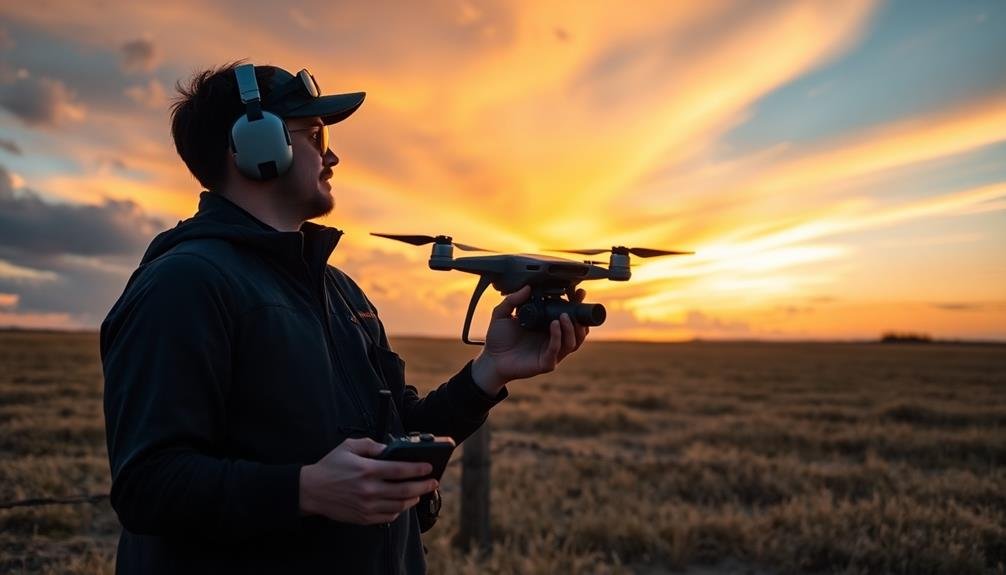



Leave a Reply